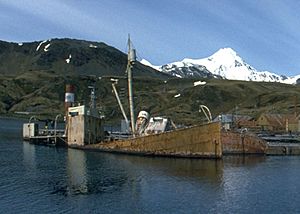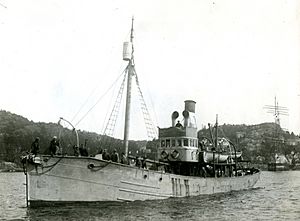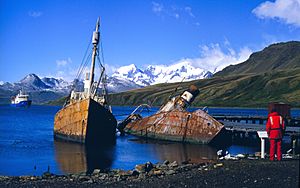Viola (trawler) facts for kids

Dias (foreground) with Albatros (heeled over) in the harbour at Grytviken, 1989. The ships have since been beached.
|
|
Quick facts for kids History |
|
|---|---|
| Name |
|
| Owner |
|
| Operator | Hellyer Steam Fishing Company |
| Port of registry | Hull, 14 February 1906 |
| Builder | Cook, Welton & Gemmell |
| Yard number | 96 |
| Launched | 17 January 1906 |
| Identification | H868 |
| Status | Derelict (2009) |
| General characteristics | |
| Class and type | Fishing trawler/naval trawler |
| Tonnage | 55 long tons (56 t) nett, 179 long tons (182 t) gross |
| Length | 108 ft 6 in (33.07 m) |
| Beam | 21 ft 6 in (6.55 m) |
| Installed power | steam |
| Speed | 9.5 knots (10.9 mph; 17.6 km/h) |
The Viola is a special steam trawler built in 1906. It was made in Hull, England. This ship is the oldest steam trawler still around! Over the years, it had different names: HMT Viola, Kapduen, and Dias. Today, the Viola rests on the beach at Grytviken in South Georgia. There are plans to bring it back home to Hull.
Contents
The Viola's Early Life
The Viola was built by Cook, Welton & Gemmell in 1906. This company was located in Beverley, England. The ship was made for the Hellyer Steam Fishing Company. After it was built, the Viola sailed down the River Hull. It went to Hull where Amos & Smith added its steam engines.
The Viola used to burn coal for power. But in 1956, it was changed to run on oil. The ship was part of the Hellyer company's fishing fleet. This fleet worked in the North Sea. Many of their ships, including the Viola, were named after characters from Shakespeare's plays.
Hellyer trawlers would stay at sea for many weeks. They would transfer their fish to faster steam cutters. These cutters took the fish to markets in eastern England. The Viola was often at sea for more than 310 days each year!
The Viola Goes to War
In September 1914, the British Navy took over the Viola. It was given the number FY 614. The ship was armed with a 3-pounder gun. It was sent to Shetland to patrol the waters. Its job was to look for U-boats (German submarines). It also helped protect other ships.
Later in the war, the Viola got a bigger 12-pounder gun. It was moved to the Tyne for minesweeping duty. This means it helped clear dangerous underwater mines. The Viola was one of the first ships to use depth charges. These are bombs dropped into the water to attack submarines. It also had special listening devices called hydrophones.
Along with other armed trawlers, the Viola helped sink at least two U-boats. One was the UB-30 off Whitby in August 1918. The other was the UB-115 off the Northumberland coast in September 1918.
From Fishing to Whaling
Many of Hellyer's fishing ships were lost during the war. After the war, the company decided to focus on fishing far away. They sold their remaining North Sea trawlers in 1918. The Viola was sold to Massey & Sons. The next year, Massey sold it to L. Thorsen in Norway. Thorsen renamed the ship Kapduen.
Later, a whaling company bought Thorsen's business. They changed the Kapduen to be a whaling ship. They even added a new bridge closer to the front of the ship. In 1924, the ship was renamed Dias. For the next few years, it hunted whales off the coast of Africa. By 1927, it was stored away in Sandefjord, Norway.
The Dias in the South
The Dias was then sold to Compañía Argentina de Pesca. This company moved the ship to Grytviken in South Georgia. Here, it was used for sealing, which means hunting seals.
The ship also helped with scientific trips in the South Atlantic. It supported the Argentine weather station at Laurie Island. It also helped the Kohl-Larsen Expedition in 1928-29. The British South Georgia Expedition in 1954-55 also used it. The Dias supported mapping work by Duncan Carse from 1951 to 1957. It also helped the Bird Island Expedition in 1958.
Rest and Decay
In 1964, the whaling station at Grytviken closed down. The Dias and another sealing ship, the Albatros, were put away. A caretaker was supposed to look after them. He painted them and kept their engines running. But he left in 1971.
Over the next few years, snow and ice piled up on the Dias. In the winter of 1974, the ship sank at its mooring. The Albatros sank the following year.
Plans for Rescue
In 2004, a project started to fix and save Grytviken. As part of this, the Dias and Albatros were refloated. All the oil was removed from them. Both ships have now been pulled onto the beach.
There is a group called "Friends of Viola/Dias". They want to save the ship. They hope to either keep it where it is or bring it back to Hull. The "Friends of Viola/Dias" think it would cost £1 million to bring the Viola home. They estimate it would cost £5 million to fix it up.
In 2006, the Viola's original bell was found. It was on a farm in Sandefjord. The Hull Maritime Museum bought the bell. In 2008, they returned the bell to the ship. In 2016, experts checked the Viola. They wanted to see if it could be refloated and fixed.
See also
- Arctic Corsair - A preserved deep-water trawler from Hull. It is much newer than the Viola.
- Ross Tiger - A preserved trawler from Grimsby. It was the last of its kind from a time when Grimsby was the biggest fishing port.
- SM U-96



